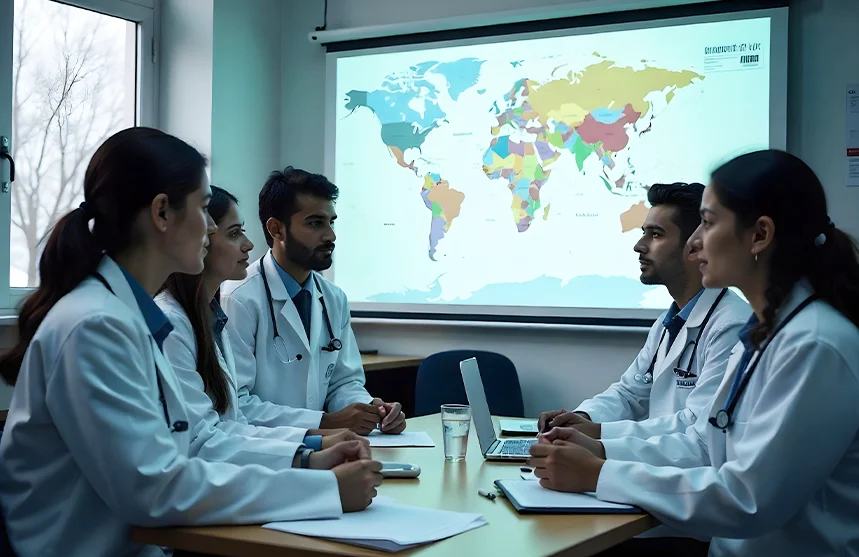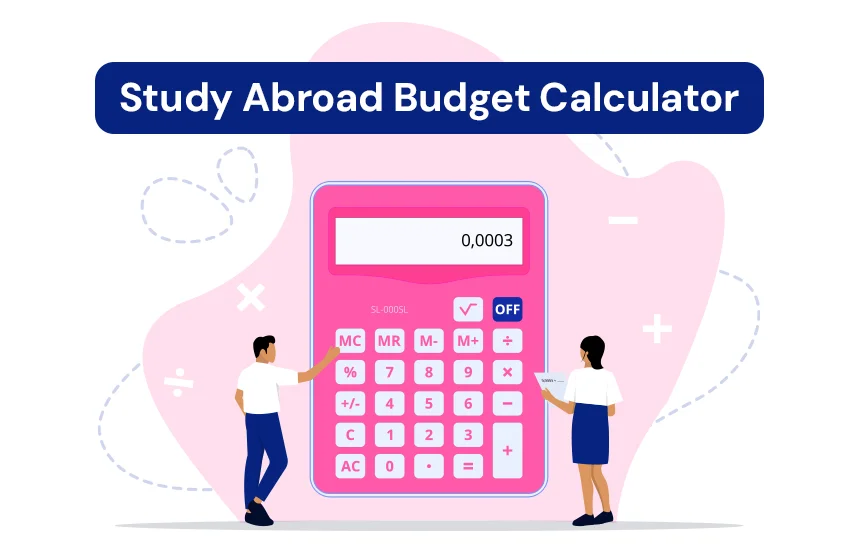How to Get a Fully Funded Scholarship to Study Abroad?
Ultimate Guide to Acing the Occupational English Test (OET) in 2025 – Everything You Need to Know

Dreaming of a Thriving Healthcare Career Abroad?
We understand. Your decision to pursue medicine wasn’t just a career choice; it was a calling to make a difference. Whether you’re already wearing scrubs or just beginning your journey into the world of healthcare, one thing is certain: effective communication can save lives.
However, when your dream hospital is located in another part of the world, speaking “good English” simply isn’t enough. You need to speak the language of healthcare. This isn’t about writing essays on climate change or having casual conversations in a café. It’s about describing symptoms clearly, documenting patient care accurately, and making critical decisions with precision and confidence.
This is exactly why the Occupational English Test (OET) exists.
Specifically designed for healthcare professionals, the OET Exam evaluates much more than grammar and vocabulary. It is not just another English test. Rather, it mirrors your actual working day in a clinical setting. It assesses how well you can reassure a nervous patient, draft an accurate referral, or engage in high-pressure discussions with clarity and professionalism.
If you’re planning to study or work in global healthcare, then the OET is definitely worth your attention.
At MetaApply IE, we recognise that passing the OET is just one part of your broader journey. That’s why, through our Be a Doctor vertical, we support you not only with exam preparation but also with every aspect of your Study Abroad Experience—from submitting your first application right through to your orientation on arrival.
But before we get to that, let’s take a closer look at what the OET exam is all about, why it matters, how it differs from other English language tests, and how you can successfully prepare for it to take your healthcare career overseas.
What is the OET Exam & Why Does it Matter?
The OET exam is a globally recognised English proficiency test, tailored specifically for professionals in the healthcare industry. Designed by Cambridge Boxhill Language Assessment, it evaluates how well candidates can understand and communicate within a clinical environment. It is accepted in major countries such as the USA, the UK, Australia, New Zealand, Ireland, Singapore, and parts of the Middle East.
Unlike English proficiency tests such as IELTS or TOEFL, which focus on general academic or conversational English, OET delves into medical terminology, patient interactions, referral letters, and healthcare-specific scenarios. If you are planning to Study Medicine Abroad or apply for licensure to practise in an English-speaking country, OET is often the preferred, and in many cases, required option.
Target group: Doctors, nurses, dentists, pharmacists, occupational therapists, physiotherapists, and professionals in 11 other regulated healthcare fields.
Accepted in: Australia, the USA, the UK, Ireland, New Zealand, Singapore, Dubai, and several other regions.
Purpose: To assess your real-world English communication skills in healthcare settings.
OET vs. IELTS/TOEFL/Other EPTs
If you are confused about whether you should take the OET exam or go with more common English tests like IELTS or TOEFL, you are not alone. However, while all of them test your English proficiency, only OET holds relevance to the world of healthcare. Here’s a quick comparison to help you understand why the OET exam aligns best with your goals, profession, and future plans as a medical professional:
| Feature | OET | IELTS/TOEFL/Other EPTs |
|---|---|---|
| Purpose | Specifically for healthcare professionals | General academic, immigration, or work purposes |
| Context of Test | Real-world clinical scenarios (e.g., patient consultations, referrals) | General or academic English contexts (e.g., essays, lectures, conversations) |
| Language Assessed | Profession-specific healthcare communication | General English proficiency |
| Skills Tested | Listening, Reading, Writing, and Speaking – all in medical contexts | Same, but more generalised and without professional relevance |
| Recognition | Widely accepted by healthcare boards and regulators (UK, AUS, etc.) | Universally accepted by universities, governments, and employers |
| Relevance | Directly applicable to day-to-day tasks in a healthcare setting | Broader language use with no professional tailoring |
| Preparation Approach | Based on a wide range of healthcare scenarios | Based on broader academic/general situations |
| Ideal For | Doctors, nurses, and allied medical professionals | Students, immigrants, general job seekers, etc. |
Basically, if your end goal involves patient communication or hospital workflows, the OET exam’s contextual relevance will give you a clear edge because it assesses the kind of language healthcare professionals actually use in their day-to-day life. Think clinical handovers, patient consultations, and discharge summaries – not describing tourist attractions or analysing pie charts like other EPTs!
Breaking Down the OET Exam Pattern
As mentioned above, the OET exam is designed to mirror the day-to-day work life of healthcare professionals. Every section is rooted in real-world clinical scenarios, so your existing medical knowledge and workplace experience can give you a real advantage. Here’s what each section looks like:
Let’s unpack what each part involves:
1. Listening Section (45 minutes)
Part A: Consultation Extracts
You will listen to two patient consultations and complete notes based on what you hear. Think of it as tuning in to real clinic conversations and picking out key details – symptoms, history, concerns – just like you’d do at work.
Part B: Short Workplace Dialogues
You will hear brief interactions like staff handovers, team briefings, or nurse-doctor instructions. The focus here is understanding tone, intention, and specific information, fast and accurately.
Part C: Presentations & Interviews
These are longer, more complex healthcare talks (think medical seminars or interviews with specialists). You will answer multiple-choice questions that test your ability to follow ideas, understand opinions, and pick up on subtle cues.
2. Reading Section (60 minutes)
This section is designed to test how you process written English in a clinical context. This section reflects the kind of reading you do on the job – whether it is quickly scanning for and summarising critical info or diving deep into research.
Part A: Expedited Reading
Four short texts (like drug labels, guidelines, or charts) where you will need to skim and scan for key facts quickly – under pressure, just like in an emergency room.
Part B: Workplace Texts
Six short extracts from memos, hospital policies, or staff bulletins. Here, you focus on understanding tone, purpose, and key points in the context of a workplace – which is helpful when reviewing standard operating procedures or safety protocols.
Part C: Extended Reading
Two longer, in-depth texts related to healthcare topics, where you analyse argument structure, interpret subtle meanings, and understand opinions. For example, think peer-reviewed journal articles or health magazine features.
3. Writing (45 minutes)
This section is the most profession-specific part of the test – and arguably the one where you can shine the brightest. You will receive detailed case notes and be asked to write a formal letter. Depending on your profession, this could be a referral, discharge, transfer, or even an advice letter.
The goal? It’s to show how effectively and clearly you communicate clinical decisions and document patient information and needs in writing, even when under pressure – something you likely would have to do every day.
Pro Tip: Use structured and professional language. Your English grammar and vocabulary matter, but clinical accuracy and appropriate tone matter more in this context.
The Money Talk: OET Exam Fees
Let’s talk about the OET exam fees. While this can vary slightly depending on the country you book it from – as of early 2025, the registration fee is approximately AUD 587 (~₹32.2K).
Payment & Booking:
- You can complete your OET exam booking directly online through the official OET website.
- Bookings usually close about three weeks before the exam date, so remember to plan accordingly.
Don’t forget: Always check the latest OET exam dates and seat availability well in advance. After all, last-minute slots can fill up quickly!
How to Apply for the OET Exam: A Step-by-Step Process
While appearing for the OET exam may not be an easy deal, applying for the test surely is!
All that you have to do is:
- Go to the official OET website and create an account.
- Select your profession, preferred country, and test location.
- Choose from available OET exam dates.
- Upload your ID and confirm your details.
- Make the payment and receive confirmation.
It truly is that straightforward. But if the process still feels a bit overwhelming, the expert team at MetaApply IE is here to support you every step of the way!
Expert Tips to Ace the OET Exam
Preparing for OET is different from preparing for a typical English test. It goes much beyond just brushing up on your English – you need to align your language skills with real-life clinical communication. Unlike general English exams, OET focuses on how well you function in a healthcare environment. That means your prep strategy must not be limited to basic vocabulary lists or grammar drills. These expert-backed strategies will help you sharpen the exact skills an OET exam evaluates:
1. Practice With Profession-Specific Materials
General English textbooks won’t cut it. The OET exam is tailored to healthcare professionals, so your preparation must be as specific as your practice. If you are a nurse or aspiring to be one, focus on patient care, instructions, and emotional conversations. If you are a doctor or aim to Be a Doctor, practice referral letters, treatment discussions, and clinical notes. Use scenarios and case notes that simulate or reflect your real work environment. You can also make use of OET’s resources, like their official website, as they offer sample test papers, writing benchmarks, scoring guides, and preparation booklets tailored for each healthcare profession. This will help you understand the exact tone, structure, and phrasing OET examiners expect, along with boosting your confidence for the test day.
2. Focus on Functional Language
The OET exam evaluates your ability to perform day-to-day tasks in English, not just grammar accuracy. Functional language refers to real, purposeful communication like explaining a diagnosis, symptoms, and treatment options to a patient, showing empathy when needed, delivering bad news, or giving instructions clearly and respectfully. Practice phrases for reassuring a worried patient, sharing sensitive information, or guiding someone through protocols. These language patterns show up regularly in OET speaking and writing tasks. Mastering them can dramatically improve your fluency, confidence, and overall score, especially in more emotionally nuanced scenarios.
3. Master Time Management
OET exams are quite time-intensive, especially the reading and listening sections. You won’t have time to overthink – in fact, you will need to scan through, interpret, and respond quickly. That’s why it’s essential to build your pacing through timed practice. Start by simulating real test conditions using full-length mock tests and a stopwatch. Get used to answering questions within strict time limits. Over time, you will develop a rhythm that helps you stay calm under pressure and maximise your accuracy without falling behind.
4. Record Your Roleplays
One of the most effective ways to improve your speaking is by recording your roleplay sessions. When you listen back, you will spot things you may have missed in the moment: awkward pauses, unnatural phrasing, repetitive words, unclear explanations, lack of empathy in tone, etc. Such self-awareness can prove to be invaluable, not just for the OET exam but also beyond that, during your actual practice as a medical professional. You will start identifying your weak spots and tracking progress over time. Plus, it’s a great way to practice tone, empathy, and fluency. Aim to simulate a real patient conversation and then evaluate it like a performance review.
5. Get Feedback from Experts
While the above-mentioned tips can be incredibly useful when preparing for the OET exam, there is only so much you can assess on your own. An experienced OET tutor or language coach can provide targeted feedback that you might not notice independently, particularly in the speaking and writing sections. They can identify subtle language issues, tone inconsistencies, or clarity gaps that could cost you valuable marks.
Many healthcare professionals see significant improvement once they receive structured and practical guidance. Think of it as clinical supervision for your English skills—precise, professional, and highly effective in boosting both your confidence and your scores.
So, where can you find this kind of expert support? Right here, with MetaApply IE.
How MetaApply IE Can Help You in OET Exam Prep
We know the drill.
The OET exam isn’t just a test for you; it’s the foundation for your global healthcare career. At MetaApply IE, we don’t believe in a one-size-fits-all approach. Instead, we tailor every step of your preparation, offering end-to-end support to ensure you’re ready not only for the exam, but for everything that comes after.
Here’s how we help you succeed:
Customised prep materials and mock tests: Based on your profession and individual strengths, what a dentist needs are very different from what a nurse does.
Hassle-free OET exam booking: No more missed deadlines. We’ll make sure your registrations are always on time – whether it’s for the exam or any part of the application process.
Guidance on all major study-abroad exams: We help you compare, choose, and prepare smartly, suggesting suitable alternatives or complementary tests when needed.
University shortlisting that fits your goals: No randomised lists – only relevant matches, especially if you’re looking to study medicine or Nursing Abroad.
Support with SOPs, Visas, loans, flights, and accommodation: We simplify the complex but essential steps so you can focus entirely on your dream.
And that’s just the beginning
The OET exam isn’t about showcasing your English skills – it’s about demonstrating that you can be the kind of healthcare professional who communicates with clarity, confidence, and compassion when it matters most. That’s what truly counts in healthcare.
At MetaApply IE, we’re here to help you not just pass the test, but thrive well beyond it. Through our Be A Doctor initiative, we offer personalised guidance, expert-led preparation, and hands-on support – from your first mock test to your first hospital badge overseas.
You’ll be backed by a team that has helped thousands of students reach their dream destinations and build fulfilling careers in healthcare. You could be next. Let’s face this exam together.
Ready to begin your healthcare journey?
Get in touch with us today and take your first step towards a truly global medical career!
Frequently Asked Questions
The Occupational English Test (OET) assesses English communication skills in clinical settings. It’s designed for 12 healthcare professions, including doctors, nurses, dentists, and pharmacists aiming to work abroad.
Unlike general tests like IELTS or TOEFL, OET focuses entirely on healthcare-specific scenarios, like patient interactions and clinical documentation, making it more relevant for medical professionals aiming to work overseas.
The OET exam is recognised in the UK, USA, Australia, New Zealand, Ireland, Singapore, Dubai, and more. It’s a preferred English test by healthcare boards and regulators in these countries.


















































